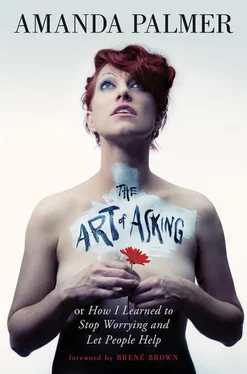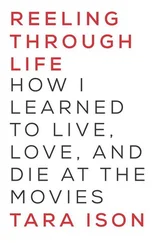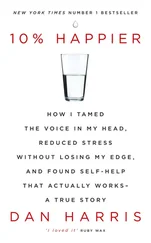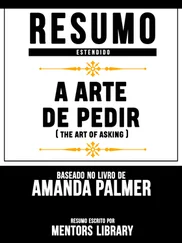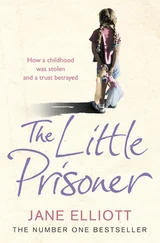The hate-mail page became the most heavily trafficked spot on our website.
People started writing to thank me for being brave enough to display the nastiness. But it didn’t feel brave; it felt like the only option, the only way I could deal with the pain. I still practice this same style of Internet jiujitsu to this day: I grab the hate and air it out, try to laugh at it, and share it back out into the world, so it doesn’t eat me alive. Around the same time that we built the hate-mail page, I started blogging regularly, sharing the good press, the bad press, and my emotional struggles riding the I AM LOVED! I AM HATED! yo-yo of praise and criticism as I tried to simultaneously balance touring, recording, managing the band, and whatever shreds were left of my local social life.
I was beginning to learn about online abuse, but, as people started to follow my blog by the hundreds, then the thousands, I also had my first taste of crowd power, and how double-edged the sword was.
We had just gotten our giant label check, paid off our loans, and had enough left over to buy a top-of-the-line drum kit for Brian and, my heart slamming with pride (I was Signed! I was Legitimate!), I started to shop for my first real piano, with a budget of about $20,000, to replace the dilapidated, untuneable piano on which I was currently composing in my apartment (someone had been about to throw it away; I’d paid the moving costs). I wanted something bright sounding and rugged, since I had a tendency to break strings. I went into every single used and new showroom in Boston, fingering the keys and nooks and crannies of every piano for sale with a kind of erotic disbelief that I was in a position to actually buy one. It felt so incredibly real .
One day I walked into a little piano shop in a converted old house in the deep suburbs. There were only a few other customers poking around; a lone nice-looking guy in a cardigan was minding the floor. I sat down at one of the baby grands and started test-driving it with some loud Beethoven, then with one of my own songs. I closed my eyes and listened, feeling the weight of the keys, hammering away like a maniac.
The guy approached me politely. I stopped playing.
Miss? Hello. I’m sorry but I’m going to have to… ask you to leave .
Holding my breath, I stood up, picked up my bag, walked out of the store and back to my car, and before I could process what had happened, I broke down crying. He thinks I’m a fraud .
I drove home and, still weepy, took to my blog. I poured out the whole story for my small readership, how ashamed and angry I felt, how devastating and embarrassing it was. I included the name of the shop, and the address, and encouraged my fans to write the guy a letter if they felt so inclined.
It wasn’t until the next day, as I read a few emails from fans who told me they had proudly written letters to the shop in protest, that I felt the gravity, the stupidity—the meanness —of what I had done.
I imagined scolding, scalding hate letters piling up on that poor guy’s desk as he tried to eke out a living running a little piano shop. Sure, he was a dick for throwing me out of his store, but wasn’t I a bigger dick to torment him like that? And wasn’t it even more dickish to use my own fans as weapons of destruction? Ashamed by my realization, I went back to my blog, removed the store name and address, and wrote a follow-up post, telling my fans that I’d been an idiot diva, that it was the insecure teenager talking. Then I prayed that the poor guy would be left in peace. I was afraid to drive down that street for a while.
I had sampled the power of cruelty. And it tasted awful.
• • •
Still, most of the early fan mail was love mail, not hate mail, and I started exchanging emails and letters with hundreds of fans. It was like having an infinite number of pen pals, and I eventually despaired when, after a few years, the number of emails coming in was more than I could keep up with. It made me feel like a bad friend.
Sometimes I’d dip into the fan mail just to cheer myself up, to feel useful to the world when I was depressed. Writing songs offered no instant gratification, but reading and answering a letter somehow did. There were recurring themes in the letters: unhappiness, rape, identity crises, self-abuse, suicidal thoughts. I answered as honestly as I could. I hope your parents eventually understand. Stay strong. I know how that feels, I’ve been there. It gets better. Yes, I’m happy to recommend some books on Buddhism. No, I haven’t always been this fearless… I was afraid to play my music for years .
During one of these answering sprees, I answered a note from a poetic, eccentric-sounding eighteen-year-old named Casey who had written to me from a hospital in Boston. She had ovarian cancer and they had put her in the children’s ward, where she was the oldest patient and having a hard time watching so many of the other children suffer. Getting to know all the parents was the worst thing, she told me. She would meet them and make friends with them and then watch them watch their kids die. After exchanging a handful of emails, I came back to Boston from a West Coast tour and, with my suitcases still unpacked, found myself staring at one of her emails on the screen.
She’d never asked me to visit. But I got in my car, happy to put off unpacking and facing my real life for an afternoon. I found her room number at the front desk, walked up, and rapped on the door. Her mother opened it, and her eyes blinked with a dawning recognition; she knew my face from The Dresden Dolls gig flyers Casey had taped to the wall of her unit. Hold on , she whispered. She scuttled back behind the curtain and I heard a yelp.
That was Casey. She was wearing a wig, because of the chemo. I stayed in her room for an hour, picking up where we’d left off over email. She showed me how she’d been taping up hopeful paintings she’d made in her windows, so the children in the ward across the courtyard could see them.
She didn’t die. We kept emailing. And gradually, she became my close friend. After she recovered, she came to Dolls shows and created beautiful chalk drawings on the sidewalks outside the clubs. Then she went to art college. Then I asked her if she needed a place to live.
She’s twenty-seven now, a painter with one ovary, the right one, and she’s been my Cloud Club housemate for five years. Lee brings her more reams of paper than she needs. She had a fish for a while named Left Ovary. Then Left Ovary died, and she named her new fish Everything.
I’d text her from the road to ask,
How’s everything?
And she’d text back,
Everything’s really good. He just pooped.
When things were particularly bad and she was going through boy trouble or something, I’d text,
Everything’s going to be okay. Everything exists.
One day, while I was on tour in Europe, I got a text from Casey saying,
Everything is gone.
• • •
The politician Tip O’Neill once said something along these lines: If you want to make someone your real friend, ask them for a favor.
As we forged along, the band made an art out of asking for help—from our housemates, from our friends, from our fans, from our family, from anybody who’d give it.
We’d done a good job of thoroughly angering and confusing the hell out of the local Boston nightclubs by showing up for gigs with our volunteer artist friends and fans, whom we’d dubbed “The Brigade.” Busker friends of mine stood outside the gigs playing accordions and posing as statues. Burlesque dancers roved around the venue in costume, handing out flowers and ripped-out pages from poetry books. Painter friends set up easels and worked, doing portraits. Volunteers decorated the sidewalks outside the venue, festooning the nooks and crannies of the lobbies and bathrooms with glitter, garlands of flowers, fortune cookies, Barbie doll heads.
Читать дальше
